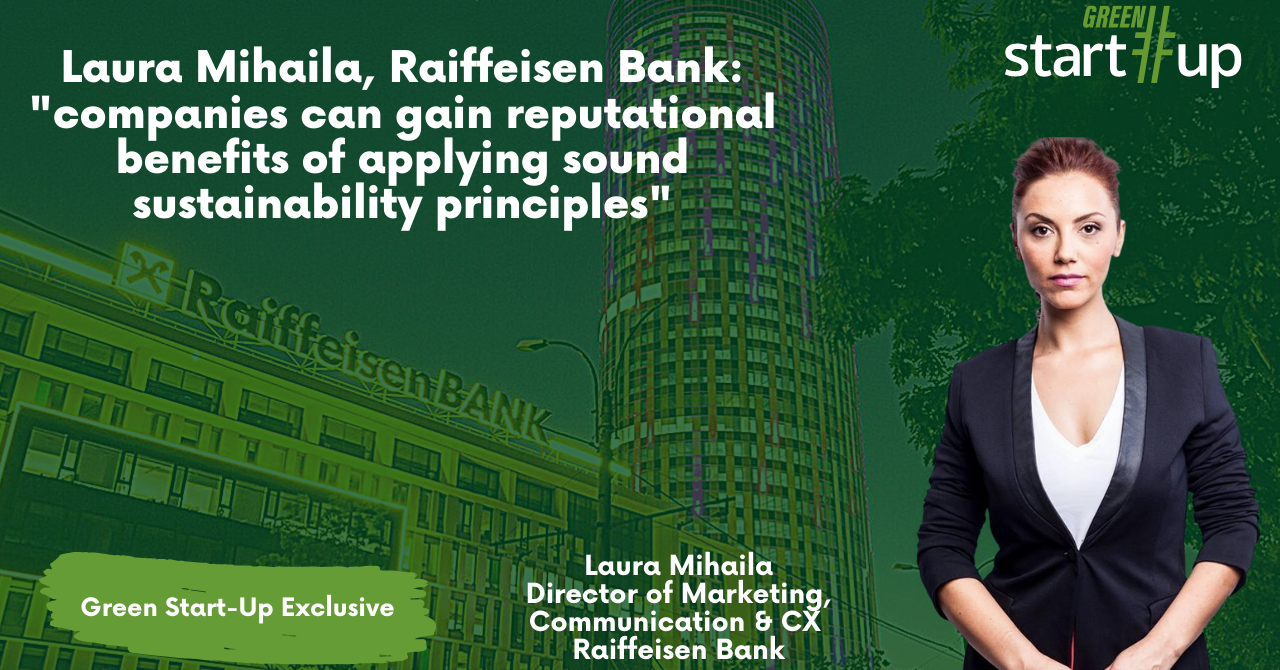First of all, how would Laura define sustainability nowadays taking into consideration the geopolitical context?
“Sustainability is a conscious decision to act, regardless of the level, be it either personal or professional, bearing in mind the fact that resources, nature and environment are not inexhaustible sources. Sustainability includes environmental, social and governance factors constituting the pillars on which sustainability is addressed”, says Laura in the beginning of our conversation.
An increasing pace for sustainability
According to her, in the business segment, the pace at which companies have begun to integrate sustainability in their strategy has been progressively increasing in the last few years.
“Companies that are integrating sustainability considerations into their strategy in early stages get advantages as they will be better prepared for the regulatory component and might gain benefits from opportunities derived from sustainability approaches”, continues Laura Mihaila, Director of Marketing, Communication & CX Raiffeisen Bank.
When it comes to Raiffeisen, the bank is actively seeking to sustain clients and transactions with ESG components.
“In Corporate finance, the solutions provided to the clients are tailor made, analyses are being performed within terms of respecting the principles of green loans or alignment with EU Taxonomy”, declares Laura.
Laura adds the fact that initiatives with sustainability themes deployed by Raiffeisen Bank also include organizing events for the bank’s clients in order to support the integrative factors of sustainability in developing strategies for them. The result? A better acknowledgement of the implication of the transition process toward a sustainable economy.
“Companies that are already voluntarily implementing sustainability principles in their regular business will be better prepared for the requirements derived from their own value chain actors, as well as for regulatory requirements that seem to be considerably increasing in the sustainability area”, tells us Laura Mihaila.
Access to funding
She urges founders and managers to take into consideration the fact that regulatory disclosure is already solicited, and more and more companies are paying attention to their partners and suppliers, as the performance of the actors from the value chain of a company will impact the Scope 3 emission of the reporting company.
“More specifically, to whom a company is collaborating will determine percent of the emissions calculated in Scope 3 We believe that it is also important that we report according to international standards. Our sustainability report is done based on GRI standards, while our community investments are analyzed using LBG methodology. This way, we can provide clear, transparent and comparable data to our stakeholders”, adds the Raiffeisen representative.
We were curious to find out if having a sustainability strategy, or just the fact that such a strategy is lacking, could influence, in the future, the access to funding of companies.
“Reverting to the EU ACTION PLAN, the first scope (out of the three stated) is to reorient capital flows toward a sustainable economy. Financial Institution requirements on reporting on sustainability aspects. For example, Pursuant to Article 8 of the European Union Taxonomy Delegated Act, requires EU banks to demonstrate the alignment with EU Taxonomy by applying and reporting Green Asset Ratio (GAR). The GAR represents the report of the financed “green assets”, as per consideration resulting from EU Taxonomy, divided per its total assets. Under such reporting obligation, assuming that GAR will become a metrics considered in the rating of the bank itself, the increase of the green portfolio is a target that will be more contoured and sustained by specific KPIs”, explains Laura Mihaila, Director of Marketing, Communication & CX Raiffeisen Bank.
The impact of sustainability initatives
And since Laura mentioned the bank’s own sustainability efforts and reaching specific KPI’s, we went on to discuss how Raiffeisen Bank measures its social and community impact initiatives.
„We measure multiple areas of our sustainability efforts, both as a financial institution and as an active contributor to societal initiative. Raiffeisen Bank issued the first green bonds in 2021, and last year the first sustainable bonds in Romania. How we calculate the impact is publicly disclosed and it is relevant for CO2 savings, energy consumption savings, for example, calculated for the different financing types”, says Laura.
According to her, when discussing social impact, managers first must align with the clear purpose of the transaction, respectively what is the intention of the company with a social purpose to obtain from such a transaction.
„Social metrics involve the differentiation between the outputs and the outcomes. The outputs refer to the number of people impacted, while the outcomes refer to how impact is generated or experienced by its beneficiaries. For example, when financing a public clinic offering access to medical services for free, one output could refer to the number of patients treated, while the outcome might be how much the level of health increased. How the social impacts are measured resides also in the strategy of the customer”, continues Laura, stating the fact that each year, the Raiffeisen team analyzes the outcomes and impact of the bank’s community investments using the London Benchmarking Group methodology and publishes the data about the non-financial performance of the company in its local annual sustainability reports, following GRI 4 standards.
Why is corporate sustainability so important nowadays and in the future? Based on its own example, Raiffeisen’s decisions take into account environmental concerns, the well-being of communities, practices that can often lead to cost savings through more efficient use of resources, reduced waste, and improved supply chain management, regulatory compliance and the competitive advantage by differentiating a company's products and services, attracting customers and investors who are looking for responsible and sustainable businesses.
„Overall, corporate sustainability is important because it can help to address some of the most pressing environmental and social issues facing our world today, while also providing economic benefits to businesses”, adds Laura.
At the same time, the Raiffeisen team is interested in working with partners and businesses that share the same goals as the financial institution regarding sustainability.
“One of our values is collaboration and we believe that if we collaborate, discuss, listen, and help each other, we will always have the desired results. For example, for SMEs clients we work with partners that offer them consultancy in developing their projects of adding green energy in their mix and our colleagues develop financing solutions to support the implementation”, mentions Laura Mihaila.
A new generation interested in sustainable services and products
She also mentions the opportunities that adhering to ESG principles can bring to Romanian companies, as well to companies all around the world.
“The opportunities we can refer to are increasing resilience of the business, increasing resource efficiency and that implies lowering the operational costs and other things like addressing new technologies and new markets. Companies, regardless of the part of the world they are acting in, can gain reputational benefits of applying sound sustainability principles, as new generations are attentive to roles the corporations are assuming in terms of sustainability”.
At the end of our interview, Laura also talked about Raiffeisen Romania’s sustainability strategy for the next few years.
According to her, since 2021 the bank strengthened its internal mechanisms for integrating sustainable development principles, both in the products and services the financial institution offers to customers and in its day to day operations.
“To connect business, environmental, and social objectives in a well-balanced way, we created our sustainability governance structure that is designed to manage and oversee the integration of ESG (Environment, Social, Governance) principles into the Bank's business and is composed of the Sustainability Council and the Sustainable Finance Committee".
When defining Raiffeisen Bank's own sustainability strategy, the team also adjusted based on the materiality analysis conducted with the bank's stakeholders yearly.
"Currently, our community investments follow 5 pillars: education, arts & culture, urban ecology, sports as a healthy lifestyle and, starting with 2021, innovation. We put a special focus on education and financial education projects, and we dedicate to it the largest amount of our community investment, 30%”, concludes Laura Mihaila, Director of Marketing, Communication & CX Raiffeisen Bank.
 Oana Coșman
Oana Coșman












Any thoughts?